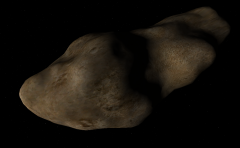| 1620 Geographos
|

|
| Geographos in Orbiter
|
| Designation
|
| Name |
1620 Geographos
|
| Reference body |
Sun
|
| Number of satellites |
0
|
| Planetary mean orbits
|
| Epoch |
|
| Semimajor axis (a) |
1.49257344448×108 km
(0.997723722661 AU)
|
| Eccentricity (e) |
0.5148753565387774
|
| Inclination (i) |
0.34575447488 radian
(19.810272158°)
|
| Longitude of the ascending node (LAN, ☊) |
2.20406746116 radian
126.2837632865°
|
| Longitude of periapsis (ϖ) |
2.96764675609 radian
170.033634209°
|
| Mean longitude (L) |
5.9410765786 radian
340.398613717°
|
| Rotational Elements
|
| Sidereal Rotation Period |
98784 seconds
(1.143333 days)
|
| Sidereal Rotation Offset |
0
|
| Obliquity |
0.1 radians
5.72958°
|
| Selected physical parameters
|
| Mean radius |
1650 km
|
| Mass |
×10<su>23 kg
|
| Density |
4.05g/cm13
|
| Equatorial gravity |
0.00099 m/s-10
|
| Escape velocity |
1.81 m/s
|
| Gravity at surface |
Cruinthe 15%
Sun 85%
|
| Note |
*Elements given are from Cruinthe.cfg file.
|
1620 Geographos is a Near-Earth object discovered in 1951 by Albert George Wilson and w:Rudolph Minkowski at Palomar and is named in honor of the w:National Geographic Society.
Geographos was to be visited by the w:Clementine mission, failed to reach the body.
1620 Geographos in Orbiter
